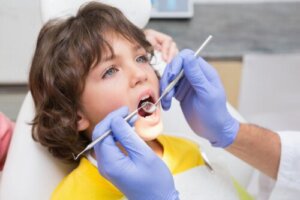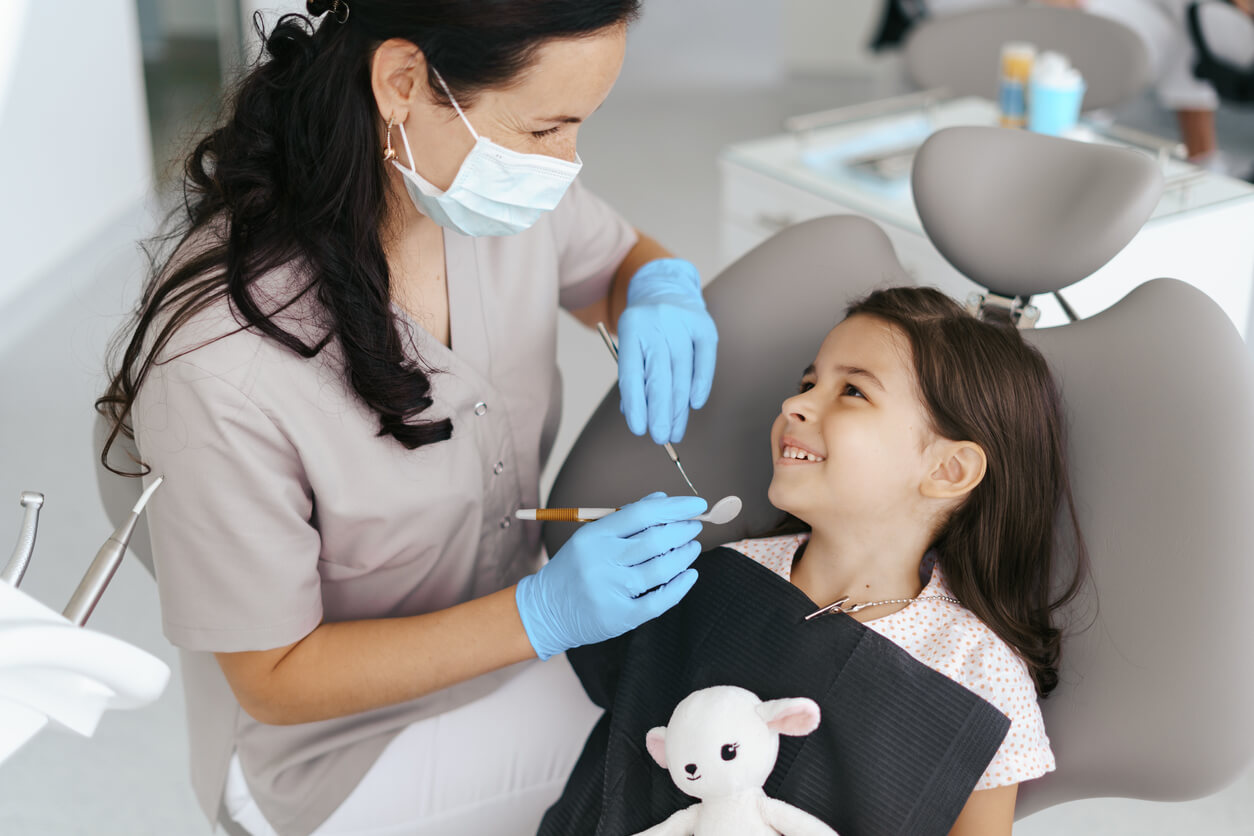When and How Often Should I Take My Child to the Dentist?


Written and verified by the dentist Vanesa Evangelina Buffa
After the first visit to the pediatric dentist, it’s common for parents to wonder how soon they should go back. In this article, we’ll tell you how often you should take your child to the dentist and why it’s important to respect this frequency.
The dentist’s role in your child’s oral health care is fundamental. Keeping their mouth healthy and accompanying their growth requires effort and responsibility. Your child’s dentist will guide and assist you in this important task.
How often should you take your child to the dentist?
According to an article published in the Journal of the American Dental Association, a child should visit the dentist within six months after their first tooth erupts or by their first birthday. After this first checkup, the pediatric dentist will schedule the frequency of checkups according to the particularities of each infant.
For its part, the American Academy of Pediatric Dentistry suggests that the most common examination interval is 6 months. However, some patients may require examinations and preventive practices at more frequent intervals. This will depend on their disease history and clinical and radiographic findings.
For children with predisposing factors for oral problems, dental visits should take place every 3 to 4 months. This allows early identification of lesions or damage. At the same time, it reinforces the relationship between the child and the pediatric dentist and educates adults about the oral care that’s appropriate to the child’s age.

Reasons to take your child to the dentist
Childhood is a stage in which many changes occur in the child’s mouth. For example, breastfeeding, the incorporation of new foods, the appearance of the first teeth, tooth replacement, the beginning of language, and the growth of the jaws, among others. The pediatric dentist evaluates, monitors, and accompanies these processes to preserve the well-being of the oral structures involved in these changes.
Visits to the dentist, then, don’t necessarily imply the presence of a problem to be solved. Just as you take your child to regular check-ups with the pediatrician, dental check-ups serve to evaluate the correct development of the oral structures and the maintenance of their health. However, in some cases, it may be necessary to go for a specific health problem.
Regular visits to the pediatric dentist
One of the reasons why it’s important to take your child to the pediatric dentist every six months is to check that everything is going well. Preserving their health is the main goal. Also, if a problem arises, the earlier it’s detected, the easier and more convenient it will be to correct it.
A cross-sectional study published by the National Library of Medicine highlights that routine dental visits are important for maintaining good oral health. Therefore, by taking care of the mouth, your little one’s overall well-being is preserved. Here are some of the practices that a pediatric dentist performs in the biannual checkups:
- Evaluation of the structures of the mouth: Examines the soft tissues, such as the tongue, palate, gums, and frenulum, and their functions. Also, the teeth, their integrity, appearance, and positioning in the arch are inspected.
- Control of the growth of the jaws and the relationship between both arches.
- Assessment of dental eruption or dental replacement, according to age.
- Identification of habits: Through dialogue with the parents and the child, the professional will inquire about the practice of certain habits that may be harmful, such as prolonged use of the pacifier or bottle, sleeping with the bottle in the mouth, thumb sucking, or mouth breathing.
- Nutritional education: Depending on the age and needs of the child, the professional will indicate specific nutritional guidelines.
- Hygiene education: The pediatric dentist teaches parents and children how to have good oral hygiene. Depending on the age of the child, the dentist will make recommendations regarding the necessary products, including a toothbrush, dental floss, toothpaste, and mouthwash.
- Application of preventive measures: Depending on your child’s needs, in some consultations, the dentist may perform dental cleanings, apply pit and fissure sealants, or perform fluoride topications.
- Dynamics and games that reinforce the relationship with the child: Strategies are implemented to help children build a bond of trust with the health professional. In this way, the aim is to prevent fear and dental phobia in the future.
Even though your child’s mouth may not seem to have any problems, regular dental checkups are important. If your little one goes to the dentist from an early age and on a regular basis, they’ll understand the need to sustain this healthy behavior throughout their life. In fact, a study published in the Journal of Public Health Dentistry indicates that dental care after infancy is associated with oral health in adulthood.
What to do when there are occasional problems
In addition to routine biannual checkups, there are situations that may arise in your child’s mouth that require you to take them to a pediatric dentist. As a mother, you should be attentive to the problems that may arise in your child’s oral cavity and seek help as soon as possible. This way, treatments will be simpler, your child will feel better, and you’ll avoid more serious complications.
These are some problems in the mouth that require you to take your child to the dentist promptly:
- Cavities: If you notice stains or gaps in your children’s teeth, it could be due to tooth decay. Treating and restoring the teeth–both baby and permanent teeth–prevents the process from progressing and worsening.
- Dental trauma: If your child suffers a blow to the mouth, there may be visible and evident lesions, but there may also be internal damage that only a dentist can detect. Even if everything seems to be fine, it’s essential to have your child evaluated urgently by a pediatric dentist.
- Dysfunctional habits: If your child sucks their thumb, grimaces when swallowing, or breathes through their mouth, it’s important to talk to your pediatric dentist. These habits alter the normal development of the jaws and predispose them to suffer malocclusions in the future.
- Tooth pain and sensitivity: Consult your dentist if your child has tooth pain or discomfort when eating something cold, hot, or sweet.
- Malocclusions: If you notice that your child’s mouth doesn’t fit correctly or has a crooked tooth, it’s important to consult your dentist.
- Bad breath: If your child has bad breath constantly throughout the day, there may be a deep problem that warrants the intervention of a professional.
- Abscesses or abscesses: If your child has a swollen face, an enlarged mouth, or pus coming out of the gum or a tooth, it’s important to consult a professional immediately.

Taking your child to the dentist, a strategy to take care of their health
Taking care of your child’s oral health requires predisposition and responsibility on your part. Having the support and guidance of a health professional will make your task much easier.
Taking your child to the dentist every six months is an ideal strategy to support their oral health. It’s also an opportunity for the professional to tell you how to continue and reinforce areas for improvement.
After the first visit to the pediatric dentist, it’s common for parents to wonder how soon they should go back. In this article, we’ll tell you how often you should take your child to the dentist and why it’s important to respect this frequency.
The dentist’s role in your child’s oral health care is fundamental. Keeping their mouth healthy and accompanying their growth requires effort and responsibility. Your child’s dentist will guide and assist you in this important task.
How often should you take your child to the dentist?
According to an article published in the Journal of the American Dental Association, a child should visit the dentist within six months after their first tooth erupts or by their first birthday. After this first checkup, the pediatric dentist will schedule the frequency of checkups according to the particularities of each infant.
For its part, the American Academy of Pediatric Dentistry suggests that the most common examination interval is 6 months. However, some patients may require examinations and preventive practices at more frequent intervals. This will depend on their disease history and clinical and radiographic findings.
For children with predisposing factors for oral problems, dental visits should take place every 3 to 4 months. This allows early identification of lesions or damage. At the same time, it reinforces the relationship between the child and the pediatric dentist and educates adults about the oral care that’s appropriate to the child’s age.

Reasons to take your child to the dentist
Childhood is a stage in which many changes occur in the child’s mouth. For example, breastfeeding, the incorporation of new foods, the appearance of the first teeth, tooth replacement, the beginning of language, and the growth of the jaws, among others. The pediatric dentist evaluates, monitors, and accompanies these processes to preserve the well-being of the oral structures involved in these changes.
Visits to the dentist, then, don’t necessarily imply the presence of a problem to be solved. Just as you take your child to regular check-ups with the pediatrician, dental check-ups serve to evaluate the correct development of the oral structures and the maintenance of their health. However, in some cases, it may be necessary to go for a specific health problem.
Regular visits to the pediatric dentist
One of the reasons why it’s important to take your child to the pediatric dentist every six months is to check that everything is going well. Preserving their health is the main goal. Also, if a problem arises, the earlier it’s detected, the easier and more convenient it will be to correct it.
A cross-sectional study published by the National Library of Medicine highlights that routine dental visits are important for maintaining good oral health. Therefore, by taking care of the mouth, your little one’s overall well-being is preserved. Here are some of the practices that a pediatric dentist performs in the biannual checkups:
- Evaluation of the structures of the mouth: Examines the soft tissues, such as the tongue, palate, gums, and frenulum, and their functions. Also, the teeth, their integrity, appearance, and positioning in the arch are inspected.
- Control of the growth of the jaws and the relationship between both arches.
- Assessment of dental eruption or dental replacement, according to age.
- Identification of habits: Through dialogue with the parents and the child, the professional will inquire about the practice of certain habits that may be harmful, such as prolonged use of the pacifier or bottle, sleeping with the bottle in the mouth, thumb sucking, or mouth breathing.
- Nutritional education: Depending on the age and needs of the child, the professional will indicate specific nutritional guidelines.
- Hygiene education: The pediatric dentist teaches parents and children how to have good oral hygiene. Depending on the age of the child, the dentist will make recommendations regarding the necessary products, including a toothbrush, dental floss, toothpaste, and mouthwash.
- Application of preventive measures: Depending on your child’s needs, in some consultations, the dentist may perform dental cleanings, apply pit and fissure sealants, or perform fluoride topications.
- Dynamics and games that reinforce the relationship with the child: Strategies are implemented to help children build a bond of trust with the health professional. In this way, the aim is to prevent fear and dental phobia in the future.
Even though your child’s mouth may not seem to have any problems, regular dental checkups are important. If your little one goes to the dentist from an early age and on a regular basis, they’ll understand the need to sustain this healthy behavior throughout their life. In fact, a study published in the Journal of Public Health Dentistry indicates that dental care after infancy is associated with oral health in adulthood.
What to do when there are occasional problems
In addition to routine biannual checkups, there are situations that may arise in your child’s mouth that require you to take them to a pediatric dentist. As a mother, you should be attentive to the problems that may arise in your child’s oral cavity and seek help as soon as possible. This way, treatments will be simpler, your child will feel better, and you’ll avoid more serious complications.
These are some problems in the mouth that require you to take your child to the dentist promptly:
- Cavities: If you notice stains or gaps in your children’s teeth, it could be due to tooth decay. Treating and restoring the teeth–both baby and permanent teeth–prevents the process from progressing and worsening.
- Dental trauma: If your child suffers a blow to the mouth, there may be visible and evident lesions, but there may also be internal damage that only a dentist can detect. Even if everything seems to be fine, it’s essential to have your child evaluated urgently by a pediatric dentist.
- Dysfunctional habits: If your child sucks their thumb, grimaces when swallowing, or breathes through their mouth, it’s important to talk to your pediatric dentist. These habits alter the normal development of the jaws and predispose them to suffer malocclusions in the future.
- Tooth pain and sensitivity: Consult your dentist if your child has tooth pain or discomfort when eating something cold, hot, or sweet.
- Malocclusions: If you notice that your child’s mouth doesn’t fit correctly or has a crooked tooth, it’s important to consult your dentist.
- Bad breath: If your child has bad breath constantly throughout the day, there may be a deep problem that warrants the intervention of a professional.
- Abscesses or abscesses: If your child has a swollen face, an enlarged mouth, or pus coming out of the gum or a tooth, it’s important to consult a professional immediately.

Taking your child to the dentist, a strategy to take care of their health
Taking care of your child’s oral health requires predisposition and responsibility on your part. Having the support and guidance of a health professional will make your task much easier.
Taking your child to the dentist every six months is an ideal strategy to support their oral health. It’s also an opportunity for the professional to tell you how to continue and reinforce areas for improvement.
All cited sources were thoroughly reviewed by our team to ensure their quality, reliability, currency, and validity. The bibliography of this article was considered reliable and of academic or scientific accuracy.
- Mark, A. (2022). Keypoints for your child’s teeth. Journal of the American Dental Association. Consultado el 29/04/2023. Disponble en: https://doi.org/10.1016/j.adaj.2021.10.005
- American Academy of Pediatric Dentistry. (2007). El hogar dental, nunca es demasiado temprano para comenzar. Consultado el 27/04/2023. https://www.aapd.org/assets/1/7/DentalHomeNeverTooEarly.pdf
- American Academy of Pediatric Dentistry. (2022). Guideline on Periodicity of Examination, Preventive Dental Services, Anticipatory Guidance/Counseling, and Oral Treatment for Infants, Children, and Adolescents. Dsiponible en: https://www.aapd.org/research/oral-health-policies–recommendations/periodicity-of-examination-preventive-dental-services-anticipatory-guidance-counseling-and-oral-treatment-for-infants-children-and-adolescents/
- Asociación Dental Americana. (s.f.) Your top 9 questions about going to the dentist – answered!. Consultado el 26/04/2023. https://www.mouthhealthy.org/dental-care-concerns/questions-about-going-to-the-dentist
- Cianetti, S., Lombardo, G., Lupatelli, E., Pagano, S., Abraha, I., Montedori, A., … & Salvato, R. (2017). Dental fear/anxiety among children and adolescents. A systematic review. Eur J Paediatr Dent, 18(2), 121-30. https://www.ejpd.eu/pdf/EJPD_2017_2_6.pdf
- Crocombe, L. A., Broadbent, J. M., Thomson, W//. M., Brennan, D. S., & Poulton, R. (2012). Impact of dental visiting trajectory patterns on clinical oral health and oral health‐related quality of life. Journal of Public Health Dentistry, 72(1), 36-44. https://onlinelibrary.wiley.com/doi/abs/10.1111/j.1752-7325.2011.00281.x
- Mosquera, D. M. B. (2022). Medición del nivel de control preventivo de la salud bucal en infantes menores de 8 años en la aparición temprana de caries dental. Journal of Science and Research: Revista Ciencia e Investigación, 7(2), 3. https://dialnet.unirioja.es/servlet/articulo?codigo=8579982
- Nazir, M. A. (2019). Predictors of routine dental check-up among male adolescents in Saudi Arabia. Acta Stomatologica Croatica, 53(3), 255. https://www.ncbi.nlm.nih.gov/pmc/articles/PMC6820442/
This text is provided for informational purposes only and does not replace consultation with a professional. If in doubt, consult your specialist.








